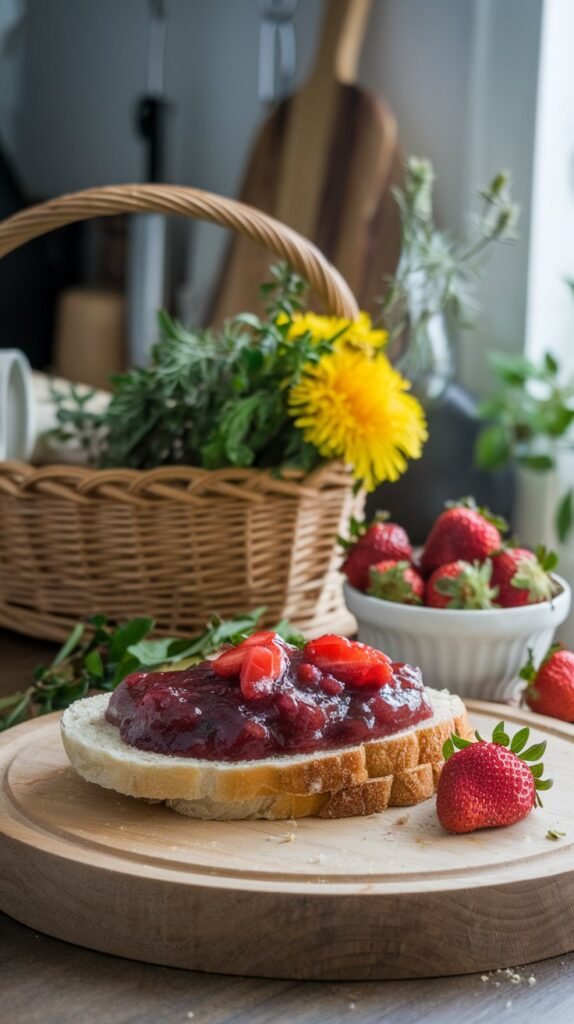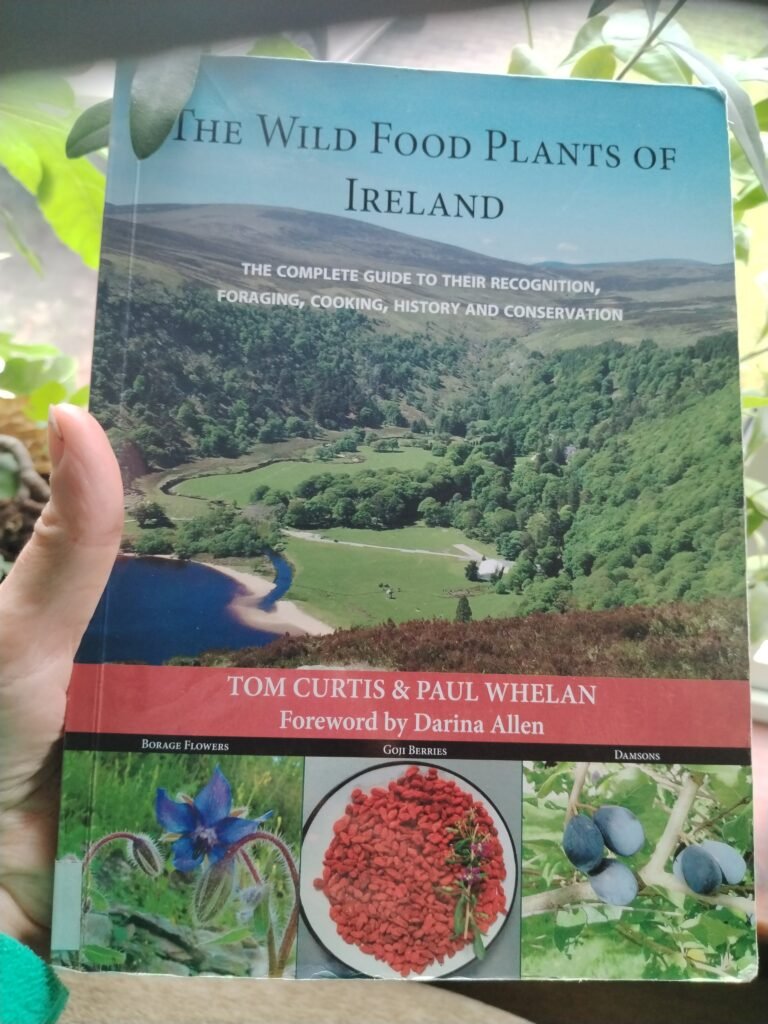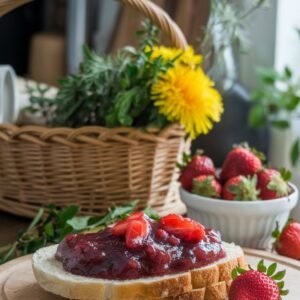

Sugar-Free Strawberry Jam with Foraged herbs & dandelion —sounds simple enough, right? But let’s step back for a moment. We live in a world where everything moves fast. We rush through our days, ticking off to-do lists, squeezing in a walk only because we know we should, barely glancing at the ground beneath our feet. Once upon a time, we walked differently. Not just for exercise, but to observe, gather, and connect.
Learning about wild herbs changed everything for me. It made me realize just how much I don’t know. There’s an entire world growing quietly around us—sweet cicely, dandelions, nettles, sorrel—yet we hardly notice. These plants were once everyday knowledge, woven into our kitchens and medicine cabinets. Now? We pass them by, reaching instead for jars of sugar and processed foods, forgetting that nature offers its own kind of sweetness.
Foraging isn’t just about food; it’s about reclaiming a slower, more intentional way of living. About pausing on a woodland path to breathe in the anise-scented leaves of sweet cicely, or kneeling in the grass to pluck golden dandelion petals, marveling at how they taste like sunshine and honey. It’s about rediscovering the land, one edible treasure at a time.
Some of the links in this post are affiliate links, including links to products on Amazon. This means if you click and make a purchase, I may earn a small commission at no extra cost to you. I only recommend items I genuinely love and believe could add value to your life. Thank you for supporting this blog—it helps keep the content free and full of ideas just for you!
Why Go Sugar-Free? The Benefits of Natural Sweeteners
We all know sugar isn’t exactly healthy. Still, have you ever stopped to think about what it really does? For starters, refined sugar disrupts your gut microbiome. It feeds harmful bacteria and throws off the balance your digestion depends on.
Over time, this imbalance leads to inflammation, energy crashes, and sugar cravings—creating a tough cycle that’s hard to break. Thankfully, nature offers better options. Instead of refined sugar, try natural sweeteners like dates, sweet cicely, and dandelion. Each one brings unique benefits. Dates, for example, are sweet and caramel-like, plus they offer fiber, vitamins, and minerals. As a result, they help slow sugar release in your bloodstream—supporting stable energy rather than spikes and crashes.
Meanwhile, sweet cicely is a forager’s dream. Its mild, anise-like flavor naturally reduces the need for extra sugar. Dandelion petals are another great option. Not only do they add floral notes, but they also support digestion naturally.
Even better, these wild ingredients don’t just replace sugar—they enhance flavor in a way refined sugar never could. When combined with strawberries, they create jam that’s complex, aromatic, and deeply satisfying. Instead of covering up the fruit’s flavor, this recipe lets it shine. The result? A jam worth savoring.
So if you’re craving something sweet but wholesome, you’re in the right place. Let’s dive into a better way.
Foraging Safety & Sustainability Tips
When heading out to forage, keep both safety and sustainability in mind. These simple tips will guide you.
By following them, you can enjoy nature’s gifts while helping preserve wild spaces for generations to come.
- Always avoid roadsides and polluted areas.
Plants near traffic often absorb toxins from car fumes, making them unsafe for eating. Instead, look for clean areas—forests, meadows, or even your own pesticide-free garden can be great choices. - Use a guidebook or plant ID app.
Some edible plants look just like toxic ones. Double-check every plant before you pick it. If you’re still unsure, ask an expert or leave the plant alone. Safety always comes first. - Harvest with care—only take what you need.
Leaving plenty behind helps plants regrow and supports local wildlife and pollinators. This way, others can also enjoy foraging without damaging the plant population. - If unsure, do a tiny taste test.
Some wild foods cause allergic reactions. Try a very small bite and wait to see how you feel. However, if you’re not confident about its safety, it’s always best to skip it entirely.
By keeping these tips in mind, you’ll forage responsibly, enjoy delicious finds, and protect the ecosystem too.
Happy foraging!
Essential Foraging Equipment
Having the right tools makes foraging safer, more efficient, and far more enjoyable. Whether you’re gathering wild herbs for your kitchen or stocking up on natural sweeteners like sweet cicely and dandelion, here are the essentials you’ll want to bring along:
- A foraging basket or cloth bag to collect plants without crushing them. A breathable bag helps keep delicate flowers and leaves fresh.
- A pair of scissors or a small knife for clean harvesting—essential for cutting stems without damaging the plant.
- Gloves for handling certain plants safely, especially when dealing with thorny or resinous species.
- A field guide or plant ID app to accurately identify what you’re foraging and avoid toxic lookalikes.
- A notebook or phone to record foraging locations, seasonal notes, and recipe ideas.
If you’re serious about foraging, a good book can be invaluable. Here are three excellent reads to deepen your knowledge:
“The Forager’s Calendar” by John Wright – A beautifully written guide on what to forage throughout the year, making it perfect for beginners and experienced foragers alike.
“Edible Wild Plants: Wild Foods from Dirt to Plate” by John Kallas – A practical book with detailed photos and preparation tips for making the most of your foraged finds.
“The wild food plants of Ireland” by Tom Curtis & Paul Whelan – A book full of amazing pictures and details about plants to find in the Irish countryside.

With the right tools and knowledge, foraging becomes a rewarding journey, connecting you to nature in the most delicious way.
How to Forage for Sweet Cicely
Where to Find It
- First, look for Sweet Cicely in hedgerows, woodland edges, and damp meadows.
- Additionally, it prefers nutrient-rich, moist soil and tends to thrive in partial shade.
How to Identify It
- Leaves: Look for feathery, fern-like foliage with a slightly hairy texture.
- Flowers: You’ll spot small, white umbels blooming from late spring to early summer.
- Scent: For confirmation, crush a leaf or stem—it should release a distinct anise or licorice scent.
Best Time to Harvest
- Ideally, harvest in spring or early summer, when the leaves are most flavorful.
- Later in the season, you can collect the seeds once they turn a deep brown.
- In autumn, dig up the roots to use as a natural sweetener.
How to Use It in Cooking
- Leaves: Use fresh in fruit salads, teas, or desserts to add a touch of gentle sweetness.
- Seeds: Alternatively, use them as a natural sugar replacement in your favorite baked treats.
- Roots: For something different, infuse the roots into syrups or hearty stews for added depth.
Lookalikes & Safety
- Be cautious: Hemlock and Fool’s Parsley closely resemble Sweet Cicely and are highly toxic.
- Therefore, always double-check the leaf shape, scent, and stem texture before picking.
- Finally, if you’re unsure, consult a trusted foraging guide or use a plant ID app to confirm.
📺 Watch this video guide on how to safely identify Sweet Cicely and avoid dangerous lookalikes:
How to Forage for Dandelions
Where to Find Them
- Almost anywhere! Dandelions grow in gardens, meadows, and roadsides (just be sure to forage away from pollution and sprayed areas).
- Look for them in sunny, open spaces with well-drained soil.
How to Identify Safe Dandelions
- Flowers: Bright yellow flower heads that turn into white, fluffy seed balls.
- Leaves: Jagged, toothed edges (hence the name “dandelion,” meaning “lion’s tooth” in French).
- Sap: When snapped, the stems release a white, milky sap.
Best Time to Harvest
- Early morning is best when flowers are fully open and full of nectar.
- Young leaves are less bitter in spring before the plant flowers.
- Roots are best harvested in autumn when packed with nutrients.
How to Use It in Cooking
- Petals: Sprinkle into baked goods, jams, and syrups for a mild, floral sweetness.
- Leaves: Add young leaves to salads, pestos, or stir-fries for a slightly bitter, earthy flavor.
- Roots: Roast and grind into a caffeine-free dandelion coffee alternative.
Sustainability Tip
- Leave some flowers for the bees! Dandelions are an essential early nectar source for pollinators.
- Avoid over-harvesting—nature thrives when we take only what we need.
📺 Watch this video on how to forage and use dandelions in your kitchen:
Foraged & Sugar-Free Strawberry Jam With Sweet Cicely, Dandelion & Dates

Foraged & Sugar-Free Strawberry Jam 🌿 With Sweet Cicely, Dandelion & Dates 🌿
Ingredients
- 500 g Fresh strawberries hulled and chopped
- 6 Dandelion flower heads only the pedals, no green parts
- 6 soft Medjool dates pitted and finely chopped
- 7 Sweet Cicely leaves finely chopped
- 1 tbsp Sweet Cicely seeds optional, for extra sweetness
- 2 tbsp Lemon juice helps set the jam and balances flavor
- 1 tbsp Chia seeds for thickening
- 100 ml Water
Instructions
- Pluck the bright yellow petals from the dandelion flowers, discarding the bitter green base.
- In a saucepan, combine the chopped strawberries, sweet cicely leaves, and seeds (if using) with the water.
- Simmer on low heat for 5-7 minutes until the strawberries start breaking down.
- Add the chopped dates and continue to cook for another 5 minutes, stirring occasionally to help them dissolve into the mixture.
- Stir in the dandelion petals and lemon juice, letting the jam cook for another 3-5 minutes.
- Remove from heat and stir in the chia seeds. Let sit for 10-15 minutes to allow the jam to thicken.
- If you prefer a smoother jam, blend lightly with an immersion blender. Otherwise, leave it with rustic chunks.
- Once fully cooled, store in a sterilized jar in the fridge for up to 2 weeks.
Notes
Serving Ideas:
🍞 Spread on sourdough toast with butter🥞 Swirl into yogurt or porridge
🍰 Use as a filling for sugar-free cakes
🧀 Pair with a creamy goat’s cheese
Conclusion: A Sweet, Wild Journey
Foraging for natural sweeteners like dandelions and sweet cicely isn’t just about replacing sugar—it’s about rediscovering flavors, traditions, and the joy of working with nature rather than against it. There’s something deeply satisfying about gathering what the land freely offers and turning it into something delicious, whether that’s a batch of floral dandelion syrup, a wild-sweet cicely-infused cake, or a spoonful of homemade jam with no refined sugar in sight.
But foraging is only part of the story. If you truly want a steady supply of fresh, natural sweetness, why not grow your own strawberries? Homegrown berries are bursting with flavor, free from chemicals, and ready to be picked at peak ripeness—perfect for your next sugar-free creation. Whether you’re stirring them into a wild-foraged jam or layering them into a naturally sweetened cake, homegrown strawberries make everything taste better. If you’re new to growing them, check out my guide on how to grow your own strawberries for the best tips on planting, caring for, and harvesting these ruby-red gems.
And if you’re inspired to take your sugar-free journey even further, don’t miss my three sugar-free jam recipes—all naturally sweetened, all bursting with real fruit flavor, and all perfect for slathering onto fresh bread or drizzling over a slice of strawberry cake. Because when nature gives us this much sweetness, who needs refined sugar?
